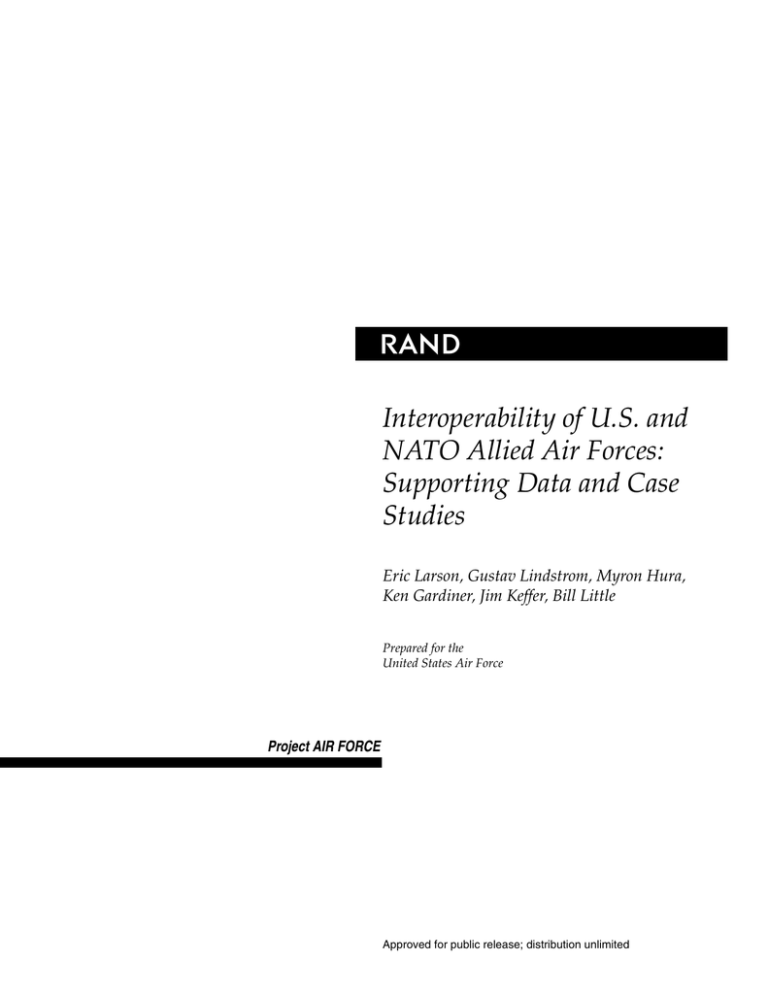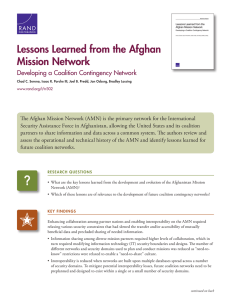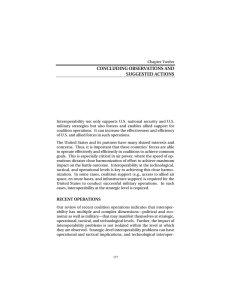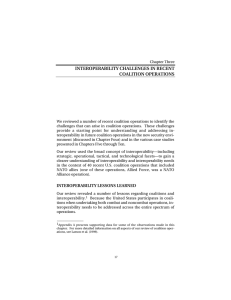
R
Interoperability of U.S. and
NATO Allied Air Forces:
Supporting Data and Case
Studies
Eric Larson, Gustav Lindstrom, Myron Hura,
Ken Gardiner, Jim Keffer, Bill Little
Prepared for the
United States Air Force
Project AIR FORCE
Approved for public release; distribution unlimited
The research reported here was sponsored by the United States Air Force under
Contract F49642-96-C-0001. Further information may be obtained from the Strategic
Planning Division, Directorate of Plans, Hq USAF.
Library of Congress Cataloging-in-Publication Data
Interoperability of U.S. and NATO allied air forces : supporting data and case studies /
Eric Larson ... [et al.].
p. cm.
Includes bibliographical references.
“MR-1603.”
ISBN 0-8330-3287-9 (pbk.)
1. United States Air Force. 2. Air forces—Europe. 3. Combined operations (Military
science) 4. North Atlantic Treaty Organization—Armed Forces. I. Larson, Eric, 1957–
UG633 .I585 2003
358.4'146—dc21
2002152425
The RAND Corporation is a nonprofit research organization providing objective analysis
and effective solutions that address the challenges facing the public and private sectors
around the world. RAND’s publications do not necessarily reflect the opinions of its
research clients and sponsors.
R® is a registered trademark.
© Copyright 2003 RAND Corporation
All rights reserved. No part of this book may be reproduced in any form by any electronic
or mechanical means (including photocopying, recording, or information storage and
retrieval) without permission in writing from RAND.
Published 2003 by the RAND Corporation
1700 Main Street, P.O. Box 2138, Santa Monica, CA 90407-2138
1200 South Hayes Street, Arlington, VA 22202-5050
201 North Craig Street, Suite 202, Pittsburgh, PA 15213-1516
RAND URL: http://www.rand.org/
To order RAND documents or to obtain additional information, contact
Distribution Services: Telephone: (310) 451-7002;
Fax: (310) 451-6915; Email: order@rand.org
xi
Summary
The United States conducts air operations with other willing NATO allies,
including non-NATO members. To help the U.S. Air Force identify potential
interoperability problems that may arise in such coalition air operations over the
next decades and to suggest solution directions to mitigate those problems, this
report applies a broad definition of interoperability used by the Department of
Defense (DoD) to explore interoperability issues at each level of military
operations—strategic, operational, tactical, and technological.1 A survey of
aggregate data and a series of detailed case-study analyses regarding recent U.S.
coalition operations with NATO allies were undertaken to better understand
interoperability through five key questions:
1. For What Missions Is Interoperability Required?
Judged on the basis of 14 recent United Nations (U.N.) operations and 26
non–U.N. operations in which the United States operated in a coalition with
NATO allies, it is clear that the United States operates in coalitions across the
entire spectrum of operations, from humanitarian relief and peacekeeping
operations in a permissive environment to major theater war. Such breadth
dictates that interoperability issues also be considered across this spectrum (see
pp. 4–6 and 49–55).
2. With Which NATO Allies Is Interoperability
Required?
Participation in U.S. coalition operations has varied greatly from situation to
situation, and over time (see pp. 6–11 and 56–85). The most frequent NATO
coalition partners in the 40 operations examined were the United Kingdom (29 of
40 operations), France (28), Turkey (23), Germany (22), and Italy and the
Netherlands (21 each); other NATO allies participated in fewer actions with the
United States.
_________________
1The definition of interoperability used by DoD and NATO is: “The ability of systems, units, or
forces to provide services to and accept services from other systems, units, or forces, and to use the
services so exchanged to enable them to operate effectively together.” DoD, Joint Chiefs of Staff, DoD
Dictionary of Military and Associated Terms, Washington, D.C.: Joint Publication 1-02, March 23, 1994,
as amended through February 10, 1999.
xii
The implication is that interoperability planning needs to be adaptive enough to
accommodate the possibility of coalitions of different sizes, and composed of
different coalition partners. “Plug and play” is a concept well known at the
technological level, but it also is required at the national level: for example, to
provide for the possibility of different combinations of coalition partners; and to
manage the comings and goings of coalition members as the mission focus
changes and/or missions are added, completed, or abandoned, while minimizing
disruptions to the overall coalition effort. This requirement suggests a broad
range of interoperability solution options, including organizations, doctrine,
procedures, and systems that can improve the ability to accommodate the
dynamic character of coalitions, including transitions.
3. For What Capabilities and Services Is
Interoperability Required?
On the basis of the operations examined, allied contributions vary greatly across
operations (see pp. 11–18 and 86–98). For example, the United States has
contributed a majority of coalition aircraft in Southwest Asia operations, and
during the recent air war over Serbia, but typically closer to four in ten aircraft to
coalition operations in Bosnia. The United States also generally tends to
contribute the broadest range of aircraft, although several nations—the United
Kingdom, France, and Italy—also seem to have breadth in their air capabilities.
These observations suggest that important roles can be played and are being
played by the United States’ coalition partners, and U.S. interoperability
planning can take advantage of these capabilities. Nevertheless, because
coalition partners vary across operations, the United States often may need to
provide the richest mix of forces, so as to provide the “glue” for the operation.
The aggregate analyses also suggest that although the United States’ NATO allies
are, relatively speaking, adequately endowed in combat aircraft, recurring
problems continue to be observed in integrating these aircraft at the operational
and tactical levels. Although notable exceptions exist, allies are generally not
adequately endowed in the sorts of support capabilities that are needed to
conduct high-intensity operations (see pp. 86–98).2 These capabilities include
refueling, mobility, intelligence, surveillance and reconnaissance, electronic
warfare, and other specialized types of systems. For example, further analysis of
potential performance gaps in areas such as precision strike capabilities and
________________
2Exceptions include France and the United Kingdom (e.g., for their Airborne Warning and
Control System [AWACS] and other capabilities) and Germany (e.g., for its electronic combat
capabilities in the Tornado Electronic Combat and Reconnaissance [ECR] systems).
xiii
sortie generation appears warranted, and to the extent that gaps are
substantiated, interoperability planning needs to address their root causes.
Analysis of mission capabilities raises important questions regarding how
coalition operations would continue in the event that U.S. low-density, highdemand (LD/HD) aircraft (e.g., U-2 or Rivet Joint) were reassigned by the
President and the Secretary of Defense to meet a higher-priority contingency in
another theater; it could very well be that shortfalls in alliance support aircraft
would leave them incapable of holding whatever gains had been made until U.S.
capabilities returned.
Finally, our analysis of basing in three combat operations in the last decade
(DESERT STORM, DELIBERATE FORCE, and ALLIED FORCE [see pp. 99–105])
revealed the importance of allied air bases in Italy to the U.S. coalition operations
in the Balkans, and those in Saudi Arabia to air operations in the Gulf War. It
also raised important questions about what sorts of operations could have been
conducted without the base access and support provided. Appropriate future
hedging actions might then include efforts to improve the capacity and
capabilities of airfields of other nations in these regions.
4. What Key Challenges Were Observed?
To complement the aggregate analyses just described, a number of recent U.S.
coalition operations—U.S. operations in Southwest Asia, Bosnia, Somalia, and
Rwanda—were examined through detailed case studies (see pp. 22–43). These
case studies revealed a number of additional important lessons regarding
challenges to coalitions and interoperability:
•
Interoperability clearly can be seen to have strategic, operational, tactical,
and technological dimensions, and interoperability problems have been
encountered at all levels in recent U.S. coalition operations.
•
The impacts of interoperability problems are not isolated within the level in
which they were observed. Strategic-level interoperability problems, for
example, tend to reverberate throughout the operational and tactical levels.
For example, divergences can develop over the political objectives of a
military operation, as in different preferences over whether to pursue total
destruction of an adversary or some agreed-upon level of damage to his
forces. In a similar vein, the absence of secure communications or the
existence of combat identification problems may greatly increase the risk of
aircraft attrition and reverberate up from the technological or tactical levels
to the strategic level.
xiv
5. What Key Workarounds Were Observed?
The case studies also revealed a number of additional important lessons
regarding workarounds to coalitions and interoperability (see pp. 22–43):
•
Interoperability workarounds—used here to connote short-term and usually
incomplete solutions to the interoperability problems that were
encountered—and longer-term interoperability solutions need to address the
fundamental sources of the problem. For example, no amount of
operational, tactical, or technological workarounds can repair an
interoperability problem whose origins are fundamentally at the strategic
level. A good example is Somalia, in which a lack of unity of purpose
compromised unity of effort and command and led to a chain of command
that proved incapable of preventing or mitigating the consequences of a
downed helicopter. By the same token, with consensus at the higher (e.g.,
strategic and operational) levels, lower-level interoperability problems are
less likely.
•
Uncertainty about what missions will be needed, which countries will
participate, the conditions under which allies will join or leave the coalition,
and what forces they will contribute creates the need for flexible
organizational structures, doctrines, procedures, and “open architecture”
systems. These elements should be lubricated by the ready availability of
liaison officers to overcome cultural and linguistic barriers and facilitate
information flow. However, in the short run the tools most likely to be
effective in managing these frictions are organizational and doctrinal
elements that enhance flexibility and adaptiveness, and routine exercise and
training in a coalition setting.
The case-study analyses, presented in Chapter 3 and Appendix C, also identified
key interoperability challenges and workarounds at the strategic, operational,
tactical, and technological levels (see pp. 22–43 and 86–98). These include the
following:
•
At the strategic level, key interoperability challenges included coalitionbuilding (DESERT STORM), access restrictions (DESERT THUNDER/FOX
and DELIBERATE FORCE), command and control and decisionmaking
(DENY FLIGHT, Implementation Force/Stabilization Force [IFOR/SFOR]),
changing political objectives (RESTORE/CONTINUE HOPE), and evolving
force structure requirements.
•
At the operational level, force planning and command and control were
among the predominant challenges encountered in the cases examined,
xv
followed by information dissemination and security issues. The case studies
also show that nations are likely to continue to maintain direct national
control of their national and theater ISR (intelligence, surveillance, and
reconnaissance) assets, rather than contributing them to a larger, shared pool
under coalition control.
•
At the tactical level, the key interoperability challenges encountered in the
case studies were quite diverse. In four cases—DESERT STORM,
RESTORE/CONTINUE HOPE, DELIBERATE FORCE, and ALLIED
FORCE—the particulars differed, but the key tactical challenge essentially
was the difficulty in conducting tactical operations with coalition forces of
varying performance capabilities. In DESERT STORM, for example,
problems with coalition tactical communications and combat identification
led to division of the battle space to separate (and deconflict) air and ground
coalition forces; the United States carried the greatest burden for some
missions (e.g., precision strike). By contrast, in RESTORE/CONTINUE
HOPE, a principal tactical issue was a shortfall in coalition C3 (command,
control, and communications) capabilities; the workaround was provision of
communications assets by the United States and extensive use of liaison
officers.
•
At the technological level, the lack of similar automated tools and compatible
and sufficient communication systems, for example, made it difficult to build
and disseminate the air tasking order (ATO) or its equivalent and to establish
and maintain secure communications among coalition aircraft. This was the
key challenge in operations such as DESERT STORM, DENY FLIGHT,
RESTORE/CONTINUE HOPE, ALLIED FORCE, and IFOR/SFOR. A
variety of workarounds were observed, including physical dissemination in
DESERT STORM and RESTORE/CONTINUE HOPE, and improved tools in
DENY FLIGHT. Workarounds to address the lack of adequate and secure
communication systems included use of unsecure communications and,
when possible, use of codes, taking the associated risk of information
compromise. Meanwhile, in IFOR/SFOR, the principal technological
interoperability challenge was managing what amounted to information
overload; few tools were available for managing the problem. The problem
of coalition-wide secure communications is a recurring challenge in coalition
operations.
The case studies also revealed other, broader lessons for interoperability
planning.
For example, a key strategic lesson from the case studies is that even when
coalition partners agree on an overall objective and military mission, they can
xvi
have distinctly different preferences, which can complicate coalition politics. In
the worst case, agreement may be somewhat nominal—a papering-over rather
than resolution of differences—while coalition partners may continue to disagree
on the specific courses of action to be pursued. In cases in which political
motives are misaligned, no amount of technological or other interoperability will
mitigate the problem.
A related lesson is that commanders and political leaders may face significant
challenges in balancing each nation’s political needs against the military
requirements of the operation, particularly when political guidance changes in
the course of an operation. Furthermore, these tensions can complicate both
command and control (the vertical dimension) and coordination (the horizontal
dimension).
Finally, differences in the perceived stakes can lead to differences in the
willingness to accept risks; in cases where the stakes for a nation are very low,
the willingness to accept risks will be commensurately low, and this can greatly
complicate unity of purpose and effort.3 At some level, policy leadership may be
a function of the willingness to accept risks—the more risk that a nation is willing
to accept, the stronger its negotiating position will be in the coalition. In cases
where the stakes and acceptable risks vary across coalition partners, the United
States may face great difficulties in forging a common purpose, effort, and
harmonized chain of command.
These analyses suggest that it is necessary to view NATO interoperability in a
way that explicitly acknowledges that interoperability issues and problems can
arise at each level of a military operation, and that the interdependencies among
the levels require that interoperability initiatives simultaneously consider the
feasibility and potential impacts at each level.
The historical perspective and lessons learned presented in this report provided
the initial starting point for the final report, which accordingly takes up where
this report concludes. The final report describes new trends that may affect
future U.S.–NATO air and C3ISR (command, control, communications,
intelligence, surveillance, and reconnaissance) interoperability; offers short- and
________________
3Operation ALLIED FORCE provides a recent example: “Nevertheless, SACEUR [Supreme
Allied Commander, Europe] acknowledges that the execution of Operation ‘Allied Force’ was
significantly affected by the need to maintain cohesion among the 19 NATO allies. Each had their
own constituencies to answer to, and varying degrees of how much risk they were willing to take.
This forced NATO military planners to introduce some strict rules of engagement—primarily an
order to limit damage to civilian infrastructure and prohibiting pilots from flying below 15,000 ft.
Clark indicates this was contradictory to the usual execution of military operations.” Interview with
GEN Wesley Clark, Jane’s Defence Weekly, Vol. 32, No. 1, July 7, 1999, posted at Jane’s website:
http://www2.janes.com/docs/definterview/dw990707_i.shtml.
xvii
medium-term solution directions for five C3ISR thrust areas (command and
control, space, air and ground surveillance and control, secure digital
communications, and fighters and weapons); and analyzes several types of
military benefits that might be expected from interoperability enhancements of
various kinds.







